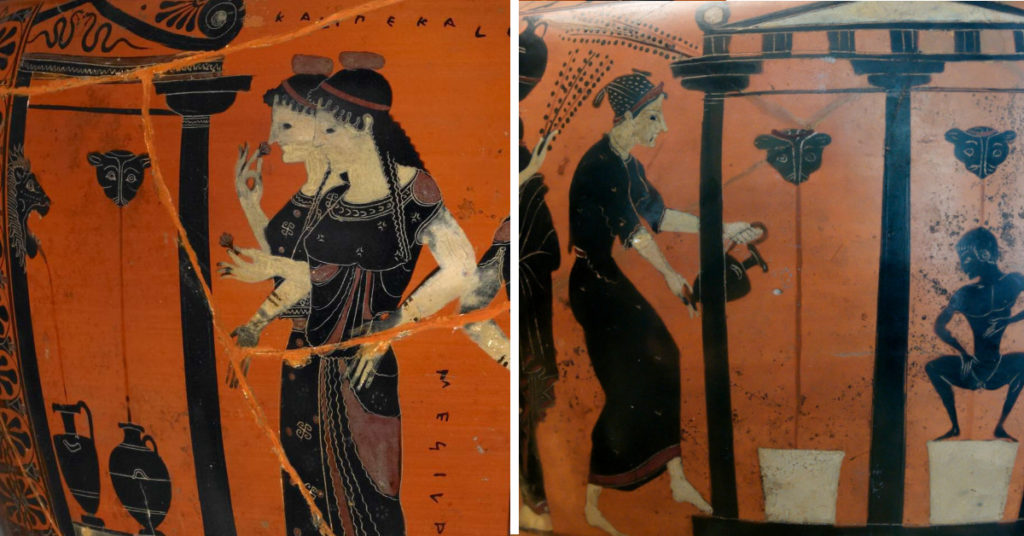Last Updated on February 13, 2022 by Editors
The value of fresh water and the need to distribute it to Outdoor Fountains is one of the main reasons why civilizations flourished, from Mesopotamia to the Greek world to the other side of the world, the Andean civilizations. With no further ado, let’s take a walk through the history of fountains.
Table of Contents
Importance of Outdoor Fountains
The presence of at least one functional fountain in a city , whether Minoan-Cycladic, Mycenean, Archaic, Classical or Greco-Roman, was very important. For instance, their importance made Pausanias (Description of Greece, Book 10) to include the outdoor fountain into the criteria of a Polis (City):
“…Panopeus, a city of the Phocians, if one can give the name of city to those who possess no government offices, no gymnasium, no theater, no market-place, no water descending to a fountain …”
The importance of fountains is so great that most of them are dedicated to Gods and Heroes and cities have derived their names by adjoining fountains. In addition, Deities such as Krenaiai (Naiades nymphs of fountains) are associated with fountains. A few centuries later, Theotokos (Mary, mother of Jesus) is represented as a fountain in Acathistus Hymn.
Power of gravity

Advanced hydro-technologies, including fountains, were first developed in Crete, the center of Europe’s first advanced civilization. Among the Greeks, outdoor fountains were very common in the cities and art. The Greeks were the first to use aqueducts to distribute water to fountains by gravity from springs and rivers. According to ancient historians and modern archeologists, fountains existed in Athens, Corinth, Smyrna, Ialyssos and other Greek cities in the sixth century BCE.
For instance, three examples of fountains are the Enneacrounos fountain, the famous fountain of the tyrant Theagenes of Megara and a few centuries later Heron’s fountain. The Enneacrounos fountain was a complete system and drainage network that covered the city of Athens with 9 fountains. Heron’s fountain is a hydraulic machine invented by the 1st century CE Greek inventor, mathematician, and physicist Heron of Alexandria. His fountain demonstrates the principles of hydraulics and pneumatics.
Some bits of ancient history of fountains
- The oldest mention of the fountain (κρήνη) belongs to Homer and his epic work “Odyssey”. Homer specifies that the fountain was made by Ithacos, Neritos, and Polyktor and it was a public outdoor fountain.
- Fountain supervisor (Επιμελητής Κρουνών) was a title of the public official responsible for overseeing Athens water supply during 5th century BCE.
Outdoor water features in India during the Hellenistic period
The Greek historian Magasthenes was sent as ambassador to the court of the Indian emperor Chandragupta Maurya (founder of the Maurya Empire) in Palibothra (Pataliputra), by the founder of the Seleucid Empire Seleukos I Nikator. In his work, Indika, Megasthenes describes the city Pataliputra (capital of the Indian empire) and mentions the city’s fountains.
Rome: Queen of the waters
Rome was famous for its aqueducts (and roads and gardens and many more). The eternal city had hundreds of public fountains (over 1000 fountains or cisterns !!) and a few dozen monumental fountains. Typically, in all important cities of the huge Roman empire many public buildings and places, like theaters and gardens, had many fountains open to the public. Also, outdoor fountains were common in the Roman villas (country houses for wealthy families).
Decline of history of fountains in the West
As we noted at the introduction, the existence of sophisticated functioning water distribution networks and terminals (such as fountains) is a crucial part of civilization. For example, it is no coincidence that the Western Middle Ages brought the significant decline of working fountains in western Europe and the decay of Roman aqueducts.
But not in the East
The Greek Nymphaion (monument consecrated to the nymphs) became a part of Roman culture and turned to Nymphaeum. Many centuries later Nymphaeum returned as Phiale.
Phiale is the most characteristic fountain of the East Roman (Byzantine) period. Fortunately, the Greco-Roman and Hellenistic tradition remained relevant in the Greek East (East Roman Empire I.e. Byzantine Empire) after the fall of its western part by the barbaric invasions.
Typically, to a degree the same applies to Islamic golden age that absorbed and applied Greek and Roman water technology among others along with Persian garden style. For instance, the Lion Fountain of Granada (Court of the lions) in Spain is a typical example of Moorish fountains.

Renaissance in the history of fountains
After Constantinople’s sacking (1204) by the Latin Christian army of the Fourth Crusade, the city-states in northern and central Italy flourished. Old aqueducts were repaired and new water systems and fountains were built.
The fall of Constantinople (1453) was the official end of the Roman Empire. However, many Roman (Byzantine Greeks) artists and scholars fled to Italy as refugees. This brought the necessary big boost to Renaissance and the latter gave us the great monumental renaissance fountains. During the renaissance, the decoration of fountains changed by using humans and god forms who gave more life to water.
The next centuries were marked by the magnificent baroque fountains that we all know and admire.

Timeless styles and designs through the history of fountains
Generally, Greek or Mediterranean fountain designs like outdoor lion head wall fountains or classic-inspired antique styles of fountains, are designs and styles that always remain on trend. In addition, outdoor fountains with anthropomorphic representations of the Buddha and other fountains with sculptures are still very popular.
Read more:
- National Park Service: A Brief Appreciation of Fountains Through History: Changing Functions, Appearances, and Meaning by John Scott
- Short Global History of Fountains
- Encyclopedia Britannica: Fountain
As an Amazon Associate I earn from qualifying purchases. We may get commissions for purchases made through links in this post.

